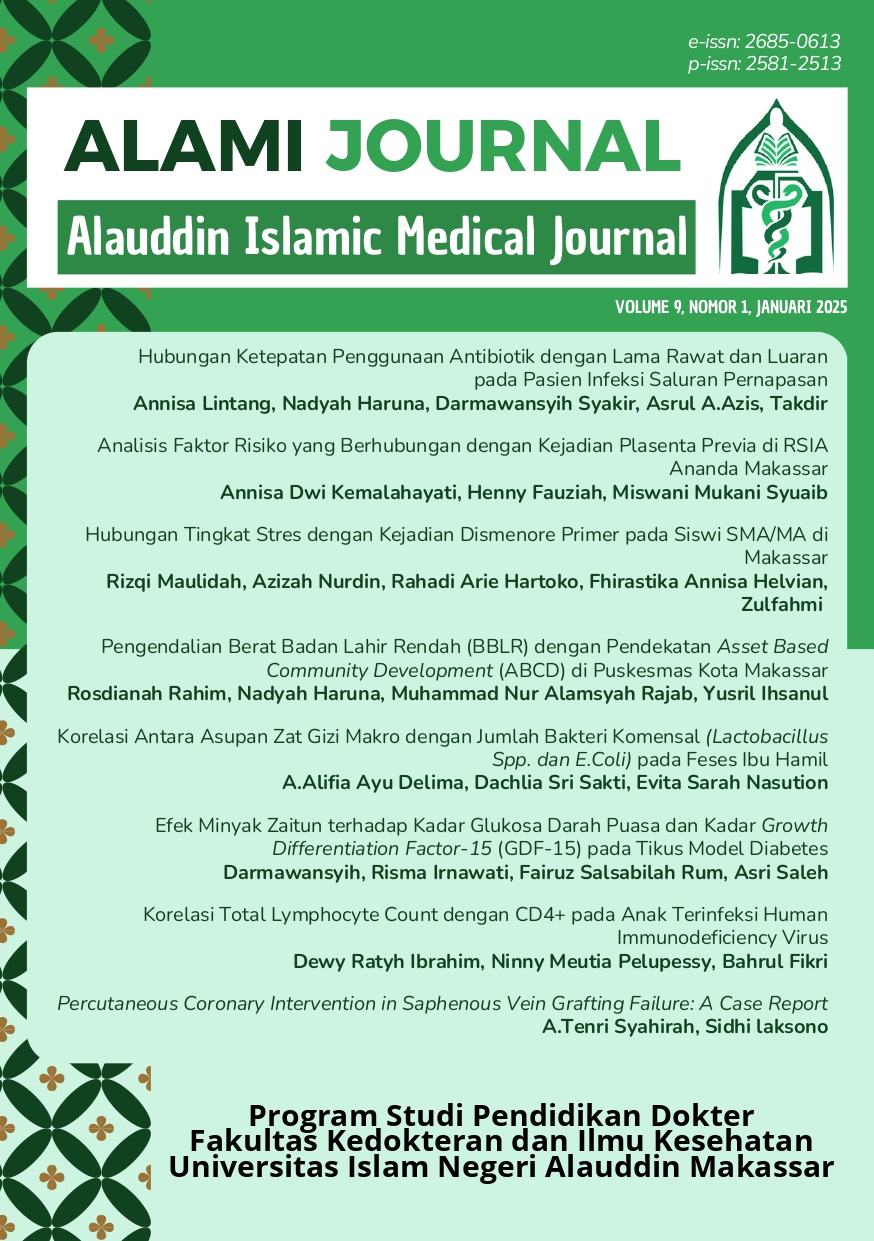Controlling Low Birth Weight (LBW) Using the Asset Based Community Development (ABCD) Approach at the Makassar City Health Center
DOI:
https://doi.org/10.24252/alami.v9i1.42877Keywords:
Asset Based Community Development (ABCD), LBW, LBW ControlAbstract
Low Birth Weight (LBW) is a birth weight of less than 2500 grams which is an indicator of a child's growth and development until adulthood and describes the nutritional status obtained by the fetus while in the womb. The community's Asset Based Community Development (ABCD) approach is used to help achieve a common goal in controlling LBW, starting with asset identification, problem analysis, potential planning, implementation, and utilization. The focus of the research was the identification of human resource assets for controlling LBW. This is qualitative research using the ABCD approach with observation and in-depth interviews. The method for choosing informants is snowball sampling in the working area of the Community Health Center in Makassar City in 2022. Based on the ABCD, this study identifies several assets involved in controlling LBW cases at the Community Health Center in Makassar City: Human Assets, namely Health services related to pregnant women's programs such as ANC visits, pregnant women's classes, and knowledge of pregnant women; Social assets, Physical assets, and Economic assets depend on the profession of each resident. These four assets are very supportive to control LBW cases in the Community Health Center in Makassar City.
References
2. Kemenkes RI. Data angka kejadian berat bayi lahir rendah. Kementerian Kesehatan RI. 2020.
3. Lengkong GT, Langi FL, Posangi J. Faktor–faktor yang berhubungan dengan kematian bayi di Indonesia. Jurnal Kesmas. 2020;9(4):41–7.
4. Hartiningrum I, FN. Bayi Berat Lahir Rendah (BBLR). Jurnal Biometrika Dan Kependudukan. 2019;7(2):97.
5. Aprilliya Wibowo Putri APLLSWAT. Faktor ibu terhadap kejadian bayi berat lahir rendah. Higea Journal of Public Health Research and Development. 2019;3(1):55–62.
6. Dinkes Kota Makassar. Data angka kejadian berat bayi lahir rendah. Dinkes Kota Makassar. 2021.
7. Green-Harris G, et al. Addressing disparities in Alzheimer’s disease and African-American participation in research: An asset-based community development approach. Frontiers in Aging Neuroscienc. 2019 May 11;1–5.
8. Prof. John L. McKnight CR. Asset-Based Community Development Process What Is Distinctive about an Asset-Based. 2018.
9. Mallapiang F, et al. Pengelolaan sampah dengan pendekatan Asset-Based Community Development (ABCD) di wilayah pesisir Bulukumba Sulawesi Selatan. Riau Journal of Empowerment. 2020;3(2):79–86.
10. Maulana M. Asset-Based Community Development : Strategi Pengembangan Masyarakat. Empower: Jurnal Pengembangan Masyarakat Islam. 2019;4(2):259.
11. Hamalding H, Irmayanti AO, Sri ika Fitriani. Hubungan status gizi ibu hamil dengan Berat Badan lahir Rendah (BBLR) di Rumah Sakit ST. Madyang Kota Palopo). UNM Environmental Journal. 2023 Aug;6(3):52–8.
12. Amalia PV, Yektiningtyastuti. Peningkatan pengetahuan ibu hamil tentang Bayi Berat Lahir Rendah (BBLR) di Desa Karanggude Kulon dan Pasir Kulon Kecamatan Karanglewas Tahun 2024. Community Dev J. 2024 Aug 17;5(4):7805–10.
13. Rosita S, Terika Afrianti. Hubungan faktor ibu dengan BBLR pada balita di Puskesmas Indrajaya Kabupaten Aceh Jaya. Serambi Akademica. 2021 Apr;93:518–25.
14. Riyanti C, Raharjo ST. Asset Based Community Development dalam Program Corporate Social Responsibility (CSR). Jurnal Kolaborasi Resolusi Konflik. 2021;3(1):115–26.
15. Budiarti I, Rohaya R, Silaban TD. Faktor-Faktor yang Berhubungan dengan Kejadian Bayi Berat Lahir Rendah (BBLR) di Rumah Sakit Muhammadiyah Palembang Tahun 2020. Jurnal Ilmiah Universitas Batanghari Jambi. 2022;22(1):195-202.
16. Supriyatun. Hubungan status sosial ekonomi dengan kejadian Bayi Berat Lahir Rendah (BBLR). Jurnal Kesehatan. 2020;8(2):974–80.
17. Astuti ER. Hubungan antenatal care dengan kejadian bayi Berat Badan Lahir Rendah di wilayah kerja Puskesmas Seginim Kabupaten Bengkulu Selatan. Jurnal Sains Kesehatan. 2020;27(1):30–4.
Downloads
Published
How to Cite
Issue
Section
License
Copyright (c) 2025 Rosdianah Rahim , Nadyah Haruna, Muhammad Nur Alamsyah Rajab , Yusril Ihsanul

This work is licensed under a Creative Commons Attribution-NonCommercial-ShareAlike 4.0 International License.
Once an article was published in the journal, the author(s) are: granted to the journal right licensed under Creative Commons License Attribution that allows others to share the work with an acknowledgement of the work's authorship. permitted to publish their work online in third parties as it can lead wider dissemination of the work. continue to be the copyright owner and allow the journal to publish the article with the CC BY-NC-SA license receiving a DOI (Digital Object Identifier) of the work.







1.png)


1.png)


.png)
.png)


